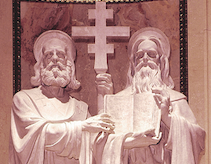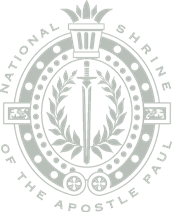Buoyed by many enthusiastic replies to our last newsletter when we shared a story behind the making of the East Rose window, we will delve into another. Archbishop Austin Dowling was instrumental in designing an inspirational and grand interior to match the spectacular Cathedral building created by John Ireland and Emmanuel Masqueray. For a story on one of Dowling’s acquisitions, we step behind the sanctuary to the Shrines of Nations.
Thank you to Marilyn Burnett, M.A., Cathedral Archivist, for her research and telling of the story.
A cheeky letter from Archbishop Dowlingin his quest for world-class art By Marilyn Burnett, M.A.

On December 7, 1925, Archbishop Austin Dowling wrote to Cathedral architects Charles D. Maginnis and Timothy Walsh, expressing his desire to hire internationally renowned sculptor Albin Polasek to create sculptures for the Shrines of Nations. A rising star in the art world, Polasek captured the world’s attention two years earlier with “The Spirit of Music” sculpture installed in Chicago’s Grant Park. The Czech-American artist and educator received numerous high-profile commissions as Dowling amusingly acknowledged in his tall request.
Letter from Archbishop Dowling

“As to Mr. Polasek, his letter is quite as interesting as himself. I should very much like to have him do all the statues if we can afford it. Would he send for an assassin if we began to deal with him on the basis of $1500 a statue for the design? … In the precincts of High Art, I feel like a burglar with a disposition to be violent if I can get away with it, and yet almost ready to be thrown out. … Try Mr. Polasek again and assure him of our reverent eagerness to get his work in our Cathedral.“
He said “yes,” but…
Polasek agreed to create one statue but with two figures. The finished piece features Saints Cyril and Methodius in honor of Slavic people in Minnesota, as well as his homeland, the Czech Republic. Polasek delighted in the prospect of honoring these ninth century missionary brothers who brought Christianity to the Slavic people and who reportedly planted a cross at the peak of Mount Radhošt in the Czech Republic, once a pagan gathering site for ancient Slavs.
In the sculpture, St. Cyril holds the Bible, which he translated in Slavonic, using a written language and Cyrillic alphabet he created for the Slavs. The older brother, St. Methodius, wears the robes befitting his rank as archbishop. Polasek took particular pride in the sculptural effects of the garment draping. The brothers’ feet are depicted stamping upon a pagan god. Polacek completed the Cathedral’s statue between 1927-28.


High Art copied for a mountain top version in Czech Republic

In 1931 Polasek fashioned a bronze replica of the Cathedral’s marble statue, at considerable personal expense, as a gift to his homeland. The figures stand at the top of Mount Radhošt, outside the ancient wooden Chapel of St. Cyril and Methodius. Polasek also sculpted a large statue of the pagan god, Radegast, which stands nearby, in recognition of the area’s pre-missionary days when pagans used the mountain top as a natural observatory to track the sun and harvest cycles.


Photo credit: Lawrence Lawyer, Director of Sacred Music, CSP



